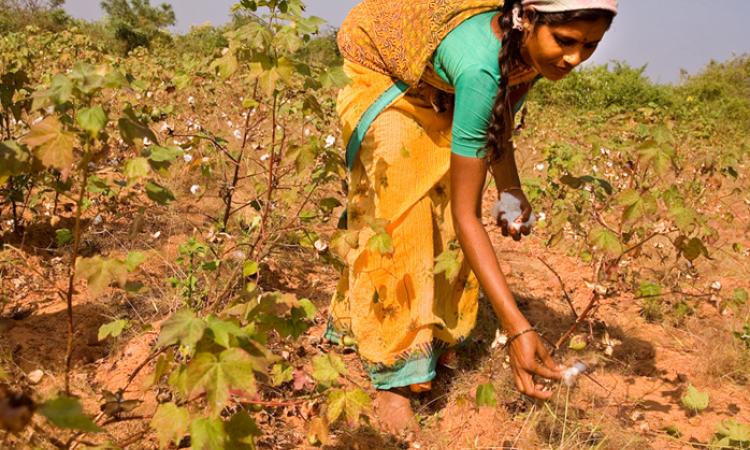
Farming is said to be witnessing a “second GR” or Gene Revolution, after Green Revolution, with the introduction of genetically modi?ed Bt cotton in India. Gujarat, Maharashtra and Andhra Pradesh are the top cotton-producing states in India with a large section namely, 81 percent, 92 percent and 98 percent of their total cultivation area under Bt cotton.
Bt cotton in Telangana
Bt cotton was taken up as early as 2002 in the state of Andhra Pradesh and the recently formed Telangana and was aggressively promoted by multinational companies who claimed that it would lead to more yield at lower pesticide costs. Farmers rapidly switched to Bt cotton and Andhra Pradesh soon became the lead cotton-producing state in the south of the country.
However, problems soon started appearing and this not only led to lower yield but also affected the soil and environment negatively due to the use of fertilisers and pesticides. Increasing input costs, lack of support from the government coupled with inadequate rainfall and insuf?cient irrigation facilities drove many farmers to commit suicide.
The study titled Generating toxic landscapes: Impact on the well-being of cotton farmers in Telangana, India published in the journal Anthropology and Medicine explores how the adoption of Bt cotton has changed the perceptions, farming practices and lives of cotton farmers in rural areas of India. The study has interviewed men and women farmers and medical professionals from the cotton-growing village of the Warangal district, Telangana state, India.
The study finds that:
- Rampant pesticide use is common among farmers
Although farmers are aware of the negative impact of the excessive use of fertilisers and pesticides on the soil, environment and health, they feel the need to use them to improve crop production, prevent pests and to make the produce more suitable for the market. Their perception of the effectiveness of agrochemicals is based on the notion, “the more the better”.
Most farmers believe that Bt cotton is prone to a number of pests and justify the continuing use of pesticides. Many of them inform that they spray insecticides in increased quantities and mix different pesticides in various ratios as a preventive measure against bollworm infestation and pests such as the sucking ?y and white insects. They purchase expensive agrochemicals based on local perceptions of effectiveness.
- Bt cotton is believed to be impure and toxic
Notions on the impact of Bt cotton on biodiversity are gendered. Women farmers express concern about too much emphasis on the cultivation of cotton and on how they now have to spend the earnings from cotton sales to buy grains, pulses and vegetables that can normally be grown in their own fields.
Most of the farmers and their families believe that Bt cotton is toxic and impure due to a toxic component introduced into the plant. Cotton from the Bt plants is thus not used to make wicks to light up lamps for religious worship. Many also say that Bt cotton stalk generates a high amount of smoke as it burns fast and thus cannot be used for cooking. Even shepherds believe that Bt cotton is toxic and do not to allow their sheep to graze in the Bt cotton ?elds.
Farmers say that they know about organic farming and vermicomposting but are unsure about the ef?ciency of these methods and the burden of labour it may exert on them and their families.
- Farmers experience health hazards due to pesticide use
Farmers report a number of health problems that they experience due to exposure to pesticides such as dizziness, nausea and itching of the skin. They also associate these chemicals with rising instances of diseases among them like cancer and diabetes, greying of hair, mental instability, lack of physical strength, and youth taking to alcohol.
However, they rarely follow safety, protection and safe disposal practices while mixing and spraying pesticides. Many do not wear protective gear while spraying, mix pesticides at home and then carry them to the farm, mix agrochemicals in the ?elds and wash containers in nearby water sources. The empty cans and packets with traces of chemicals are thrown near ?elds or water sources. Majority of farmers do not seek medical help for minor incidents of pesticide poisoning.
Registered medical practitioners are available at the village level to offer primary health care services. However, many do not administer treatment in cases of pesticide ingestion, either accidental or willful. This is because until 2017, attempted suicide was a punishable offence according to the Indian Penal Code. Due to this, self-harm cases were reported as "accidents" and there is no follow-up of treatment. Many patients are thus left untreated and vulnerable.
Multipronged approach to deal with farmer distress needed
The study argues that cotton farming villages in India are being rapidly transformed into physically and socially toxic landscapes where farmers are caught in a web of local, national and international factors that interlink to cause distress. The study highlights the need for collaboration between cotton farmers, agricultural and social scientists, and health professionals and the development of socially relevant interventions for cotton farmers in India.
A copy of the paper can be downloaded from below:
/articles/gene-revolution-adds-farmer-distress